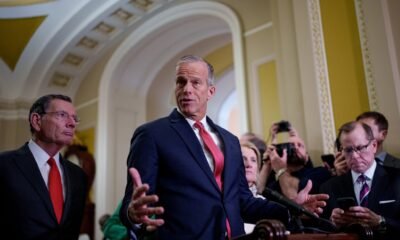Entertainment
Senators Demand Enhanced Disability Benefits for Long COVID Sufferers

Several U.S. senators are urging the Social Security Administration (SSA) to make it easier for Americans with long COVID to access disability benefits. Disability rights advocates and patients have long advocated for these changes, highlighting the urgent need for action.
A letter released on Monday and signed by Senators Tim Kaine (D-VA), Ed Markey (D-MA), Tammy Duckworth (D-IL), Bernie Sanders (I-VT), Tina Smith (D-MN), Angus King (I-ME), and Richard Blumenthal (D-CT) called for more transparency from the SSA. The lawmakers want the agency to track and publish data on long COVID applications and consider expanding the list of impairments recognized in disability claims.
“In some situations, these symptoms can be debilitating and prevent an individual from being able to work, take care of their family, manage their household, or participate in social activities,” the senators wrote to SSA Commissioner Martin O’Malley.
Long COVID is a chronic health condition that commonly includes symptoms such as fatigue, brain fog, and shortness of breath after a COVID-19 infection. Data from KFF’s April analysis indicated that approximately three in ten American adults have experienced long COVID. In March 2024, around 17 million people were reported to have the condition. The U.S. Department of Health and Human Services recognized long COVID as a disability under the Americans with Disabilities Act in 2021.
Senator Kaine has shared his own long COVID experience, while Senator Sanders has introduced legislation to allocate $1 billion annually for ten years to support long COVID research by the National Institutes of Health.
Lisa McCorkell, co-founder of the Patient Led Research Collaborative, emphasized the importance of specific guidance. “Creating a ruling or listing would be a huge improvement — having that specific guidance for how to document long COVID, its related diagnoses, and its associated impairment would assist physicians who may not be as knowledgeable about long COVID,” McCorkell told States Newsroom.
The SSA oversees disability benefits through the Social Security Disability Insurance and Supplemental Security Income programs. Unlike the former, the latter does not require previous employment contributions and is based on financial need. Applicants must prove they qualify as having a disability to receive benefits. Currently, the average monthly disability benefit for Social Security Disability Insurance stands at $1,538.
Researchers and economists are working to gauge the full impact of COVID-19 infections and long COVID on the workforce. A 2023 study estimated a reduction of 500,000 workers due to COVID-19, with the average labor loss translating to $9,000 in earnings. According to a 2022 Minneapolis Fed paper, over 25% of people with long COVID reported impacts on their employment or work hours.
Marissa Ditkowsky, disability economic justice counsel at the National Partnership for Women & Families, expressed concern about the ongoing implications of long COVID. She noted, “COVID disproportionately impacts women, disabled folks, and people of color who already face barriers to healthcare, employment, and equitable wages.” Ditkowsky stressed the need for proactive measures to prevent long COVID while supporting those who already suffer from the condition.
Advocates argue that changes such as the restoration of the treating physician rule, which was repealed in 2017, could significantly benefit people with disabilities. This rule previously allowed the SSA to give more weight to medical evidence from a physician who had an ongoing relationship with the patient compared to a one-time examiner. “Giving your own doctor the weight [they] deserve is huge,” Ditkowsky said.
Mia Ives-Rublee, senior director of the disability justice initiative at the Center for American Progress, suggested that the current and future administrations could revamp how the SSA administers disability benefits. “Not only are we seeing an increase in disability in younger folks, but we’re also looking at the big boomer generation getting older. We need to see real changes and funding to manage the wide variety of experiences that people have in order to deal with differences in applying for these benefits,” she stated.

















